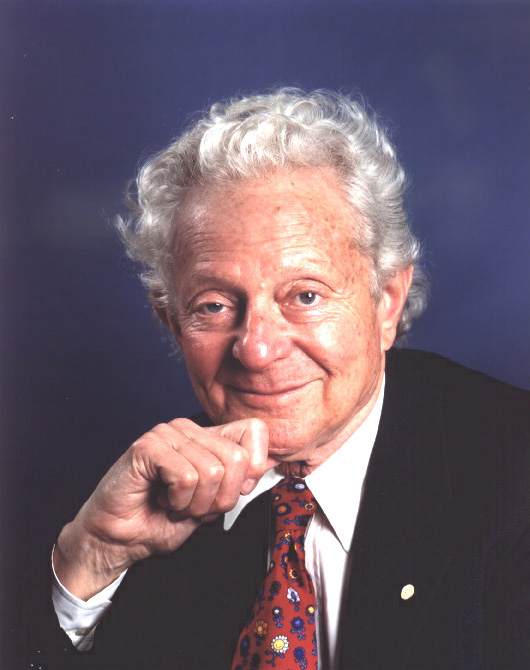Leon Lederman, the K-meson,
the Muon
Neutrino, and the Bottom Quark
His Honors · His
Involvement in Science Education
His
Wisdom and Humor · Resources
with Additional Information
Leon Lederman started his career in Physics at Columbia University,
where he earned his Ph.D. in 1952. He ‘stayed on at Columbia
following his studies, remaining for nearly 30 years, as the Eugene Higgins
Professor and, from 1961 until 1979, as director of Nevis Laboratories in Irvington,
the Columbia physics department center for experimental research in high‑energy
physics. ...
 Courtesy of Fermilab
Courtesy of Fermilab
In 1956, working with a Columbia team at the Brookhaven National Laboratory
on Long Island, Lederman discovered a new particle, the long‑lived
neutral K‑meson, which had been predicted from theory. Further
research at Columbia demonstrated the non‑conservation of parity
during muon decay. ...
In 1962, Dr. Lederman, with his colleagues Melvin Schwartz and Jack Steinberger,
succeeded in identifying ... the muon neutrino, [which] eventually netted Lederman
and his partners a Nobel Prize in Physics. ...
This early award‑winning research in high‑energy physics brought
Dr. Lederman into national science policy circles and in 1963 he proposed the
idea that eventually became the Fermi National Accelerator Laboratory
in Batavia, Illinois.
The design of ever more powerful accelerators, first at Brookhaven National
Laboratory, enabled Lederman and his team to find the first anti‑matter
particle in 1965. In 1977 Lederman led the team at Fermilab that discovered
the subatomic particle known as the bottom quark. The following year he was
named Director of the laboratory. By 1983, his administration had brought Fermilab
into a position of international prominence with the construction of the world's
most powerful superconducting accelerator, the Tevatron.
A convinced proponent of science education, Lederman opened Fermilab to countries
not previously associated with high energy physics. During his term as Director,
Lederman also emphasized the importance of math and science education as outreach
to the neighboring communities. He initiated the Saturday Morning Physics lectures
and subsequently founded the Friends of Fermilab.
The 1988 Nobel
Prize in Physics was awarded to Lederman
and his old partners, Schwartz and Steinberger for "transforming the ghostly
neutrino into an active tool of research." In 1989, Dr. Lederman stepped
down as Director of Fermilab and assumed the title director emeritus. He then
served as Frank L. Sulzberger Professor of Physics at the University of Chicago,
and pursued his increasing interest in the problems of science education in
American schools. He founded the Illinois Mathematics and Science Academy,
the first state‑wide residence public school for gifted children, and
the Teacher's Academy of Mathematics and Science in Chicago. ...
In 1994, researchers at Fermilab achieved an old goal of Dr. Lederman's, detecting
the top quark, the bottom quark's elusive companion, which had escaped observation
for the previous 17 years.’
Top
Additional information about Leon M. Lederman, his research, and his interests
is available in full text and on the Web.
Documents:
Observation
of High‑Energy Neutrino Reactions and the Existence
of Two Kinds of Neutrinos; Physical Review Letters, Vol.
9, Issue 1: 36‑44; July 1, 1962
Neutrino Physics,
DOE Technical Report, January 1963
Remarks
Concerning the Recent High‑Energy Neutrino Experiment;
Physical Review Letters, Vol. 10, Issue 6: 260‑262; March 15,
1963
Observations in Particle Physics from Two Neutrinos to the Standard
Model; Review of Modern Physics, Vol. 61, Issue 3: 547‑560;
July 1989
A Diffusion Cloud Chamber Study of Very Slow Mesons. II. Beta Decay
of the Muon, DOE Technical Report, March 1995
The
Discovery of the b Quark
at Fermilab in 1977: The Experiment
Coordinator's Story, DOE Technical Report, December 1997
Top
Top
Additional Web Pages:
Top
|



